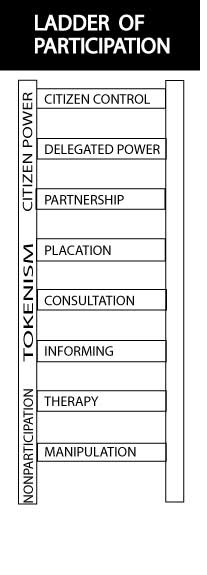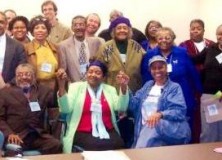 ARTICLE ADAPTED FROM SHERRY ARNSTEIN, “LADDER OF PARTICIPATION”
ARTICLE ADAPTED FROM SHERRY ARNSTEIN, “LADDER OF PARTICIPATION”
Citizen participation is a categorical term for citizen power. It is the redistribution of power that enables the have-not citizens, presently excluded from the political and economic processes, to be deliberately included in the future.
However, a lot of what passes for citizen participation is merely an empty ritual of participation and denies participants the real power needed to affect the outcome of the process. An eight step ladder analysis illustrates this issue.
The bottom rungs of the ladder are (1) Manipulation and (2) Therapy. These two rungs describe levels of “non-participation” that some have contrived to substitute for genuine participation. Their real objective is not to enable people to participate in planning or conducting programs, but to enable powerholders to “educate” or “cure” the participants.
Rungs 3 and 4 progress to levels of “tokenism” that allow the have-nots to hear and to have a voice: (3) Informing and (4) Consultation. When powerholders provide this as the total extent of participation, citizens may indeed hear and be heard, though they lack the power to insure their views hold some weight. At this level, no assurance of changing the status quo exists.
Rung (5) Placation is simply a higher level tokenism because the ground rules allow have-nots to advise, but retain for the powerholders the continued right to decide.
Further up the ladder levels of citizen power give citizens increasing degrees of decision-making clout. Citizens can enter into a (6) Partnership that enables them to negotiate and engage in trade-offs with traditional power holders.
At the topmost rungs, (7) Delegated Power and (8) Citizen Control, have-not citizens obtain the majority of decision-making seats, or full managerial power.
Obviously, the eight-rung ladder is a simplification, but it helps to illustrate the gradations of citizen participation that exist in a given society. Knowing these gradations makes it possible to cut through the hyperbole to understand citizens demands for participation in the context of the confusing responses from the powerholders.
Part of citizen participation involves power analysis – who has the power in the given community? What are their self-interests? Whether discussing private sector players with a profit motive, public sector players seeking to promote their political agendas, or simply the dominant culture that holds sway in a given area, power analysis allows community members to understand the dynamics that keep them trapped in the lower rungs of the citizen participation ladder.
Increasing citizen participation – in research efforts, public policy decisions and in the formulation of research projects themselves – is a fundamental goal of the SCRC. As such, power analysis is one of the tools we use to promulgate awareness that can then empower communities to act as decision-makers in their own lives, and to improve their communities.
Source: A Ladder of Citizen Participation – Sherry R Arnstein

